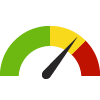Digital Access Indicators
The COVID-19 pandemic highlighted the influence that digital access has on health. Broadband access in now considered a super social determinant of health (SDoH), as it is essential in addressing other SDoH, including economic sustainability, education, and access to health care (reference: Digital inclusion as a social determinant of health). Disparities in digital access exist not only in rural areas, but also in urban areas, the latter resulting from digital redlining practices that exclude low-income neighborhoods from accessing broadband services (reference: County Health Rankings & Roadmaps).
This dashboard includes indicators related to digital access from the U.S. Census Bureau's American Community Survey (ACS) 5-year estimates and the Claritas Consumer Profiles annual estimates, specifically from the Nielsen Scarborough USA+ Annual Survey (click here to learn more). Claritas is a nationwide market research group. The Nielsen Scarborough USA+ Annual Survey is a national consumer study to evaluate marketing opportunities and consumer behavior across markets. This survey uses a two-phase methodology that includes a randomly dialed telephone interview and a self-administered consumer survey booklet. Once the data is collected, each individual survey respondent is assigned a segmentation system code based on self-reported demographic data such as age, income, and presence of children. Through these methods, Claritas is able to provide current year estimates of people's behavior, product/service usage, and lifestyle information.
The Claritas Consumer Profiles data are collected for market research purposes, and use a different sampling methodology than the U.S. Census Bureau's ACS. The representativeness of the Claritas data are unknown. Please note that "Adults with Internet Access" (source: Claritas Consumer Profiles) shows the percentage of adults with internet access at any location (work, home, or elsewhere) whereas "Persons with an Internet Subscription" (source: U.S. Census Bureau's ACS) shows the percentage of people in households that have an internet subscription at home or on a mobile device.
Indicator Gauge Icon Legend
Legend Colors
Red is bad, green is good, blue is not statistically different/neutral.
Compared to Distribution
 the value is in the best half of communities.
the value is in the best half of communities.
 the value is in the 2nd worst quarter of communities.
the value is in the 2nd worst quarter of communities.
 the value is in the worst quarter of communities.
the value is in the worst quarter of communities.
Compared to Target
 meets target;
meets target;  does not meet target.
does not meet target.
Compared to a Single Value
 lower than the comparison value;
lower than the comparison value;
 higher than the comparison value;
higher than the comparison value;
 not statistically different from comparison value.
not statistically different from comparison value.
Trend

 non-significant change over time;
non-significant change over time; 
 significant change over time;
significant change over time;  no change over time.
no change over time.
Compared to Prior Value
 higher than the previous measurement period;
higher than the previous measurement period;
 lower than the previous measurement period;
lower than the previous measurement period;
 no statistically different change from previous measurement period.
no statistically different change from previous measurement period.
State: Ohio
Source: Claritas Consumer Profiles


State: Ohio Adults with Internet Access
State: Ohio Adults with Internet Access




State: Ohio Households with a Computer
State: Ohio Households with a Computer




State: Ohio Households with a Smartphone
State: Ohio Households with a Smartphone




State: Ohio
Source: U.S. Census Bureau's American Community Survey (ACS)
State: Ohio Households with an Internet Subscription
State: Ohio Households with an Internet Subscription






State: Ohio Persons with an Internet Subscription
State: Ohio Persons with an Internet Subscription





